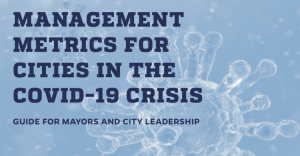Making the most of the Management Metrics for Cities resource

In the past three months, city leaders across the country have grown comfortable reciting local data on COVID-19 cases, hospitalizations, ventilator usage, and more. As the pandemic evolves, however, so do the metrics they need to master.
That’s why Bloomberg Philanthropies last week released a guide to COVID-19 Management Metrics for Cities. It’s meant to help mayors and their lieutenants track the right data points to keep tabs on how the pandemic is impacting their city over time and make informed decisions as the crisis continues.
The guidance was developed by the Johns Hopkins Bloomberg School of Public Health and What Works Cities, an initiative that promotes data-driven decision making in city halls. To help city leaders put it to use and use data to lay the foundation for an equitable recovery, What Works Cities will be offering new technical assistance and training opportunities. Webinars on using data and this metric set to tackle COVID-19 in your community are available here. A new webinar with Dr. Joshua M. Sharfstein of Johns Hopkins will be held on July 13.
To find out more about these new resources, we caught up with Beth Blauer, executive director of the Centers for Civic Impact at Johns Hopkins.
Why is the management metrics guide needed?
For a number of reasons. There’s a lot of data and guidance and tools out there being marketed toward policy makers to help guide decision making. We are trying to put some gates around what’s out there to give mayors confidence. This is such unchartered territory. We’ve had lots of conversations with cities, and mayors are looking for that validation. They want a trusted partner like Bloomberg to come in and help them make sure that they’re being thoughtful and that they’re looking at it in a comprehensive way.
The Johns Hopkins piece of this is also really big. The fact that we have the number one public-health program in the world lending expertise into this process brings a lot of comfort to those cities that are trying to navigate this on their own.
How do you expect mayors and city leaders will use it?
The metrics are to support mayors around a whole series of decisions they have to make. For example, in states where mayors have authority over relaxing social distancing, or what kinds of industries are opening and jobs are being brought back online, this will help them make those decisions based on data.
There are also decisions to be made surrounding frontline city workers. We have inspectors who are going into homes, people collecting money, or having other touchpoints with the public. The metrics are meant to help drive internal decision making around those contacts with residents, as well.
The first matter of business is to make sure you have access to the data points that are recommended in the metric set. And then you need to start building out your routines as a city to make sure that you’re looking at the data as a leading component of your decision making.
Are the data mostly for internal use, or should it be part of the public-facing COVID-19 data dashboards many cities have rolled out?
It’s definitely something the public should see, because the data also give some context to the decisions themselves. When you have black-box decision making and you’re not transparent, then it opens questions about trust. When it comes to case tracing or anything that could reveal identifiable information about individuals, those things should be kept internal and protected.
How can these metrics help in the fight against racial and ethnic disparities we’re seeing in COVID-19’s impact?
We’re seeing across the United States that Black and Latino populations are absorbing the brunt of this disease. We need to really emphasize the need to have the data broken down by race. And that includes disproportionality in cases, deaths, access to testing. There are huge swaths of our country that still are in desperate need of prolific testing. People dying in places where there is no testing capacity, which means that there’s probably widespread disease, but we just don’t know it.
That’s happening disproportionately in Black communities, in Latino communities, and also in Native American communities. It’s not a huge surprise given the fact that structural racism has been exacerbating health outcomes for generations. But there is now clear evidence of the failure of our health system, when we see 2-to1 and 3-to-1 ratios of Black and Latino residents getting and dying from the disease and being blocked from access to testing.
How much of this data do cities already have access to? And how much of it will they have to go out and find?
A lot of cities are waking up to the realization that they should have had inter-governmental data sharing agreements in place before now. Because they’re so heavily reliant on their county or state health departments to get data specifically about their populations. If we can learn one thing from COVID-19, it’s that we need to have these mechanisms in place. Not just for pandemic tracking, but for all the different kinds of health disparity data that we know is manifesting in these communities.
Cities that have robust health departments of their own are a bit better poised to be able to get some of the more granular data. And we’ve been seeing ad-hoc relationships that have developed where mayors are getting this information because they’re demanding it from their governors or county health officials. A lot of cities, even those that are on the smaller side, have done a really incredible job of getting the data and getting it out into the public.
And what about when it comes to interpreting these data points. Some of these measures, like test positivity, are new to most local leaders.
There are standards. For example, the World Health Organization says we want testing positivity in a community to be below 5 percent — that means that of all the tests that are given, only 5 percent or below are positive. And that’s a good indication that you can relax some of the social distancing measures. Those are things that we’re trying to build muscle around with policymakers is to look at those kinds of validated standards.
What technical assistance is available for cities around these management metrics?
For a small number of cities, we’re going to be helping to deploy use of the metrics in the management routines of city hall decision making. We’re also going to be helping some cities create their own dashboarding if they don’t already have it, to get the data into the public. If you work in a city and are interested in support for your COVID-19 work, please send us an email at civicimpact [at] jhu.edu.

